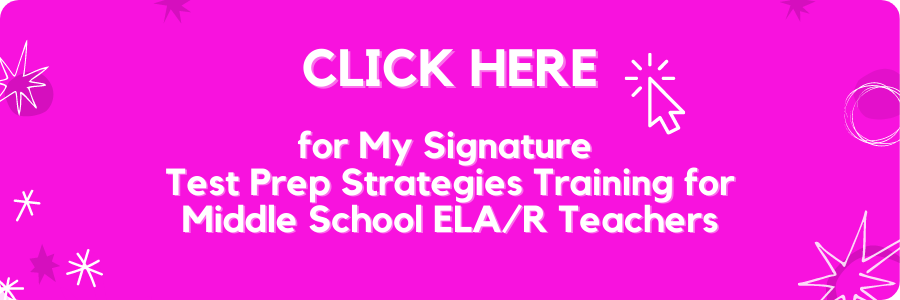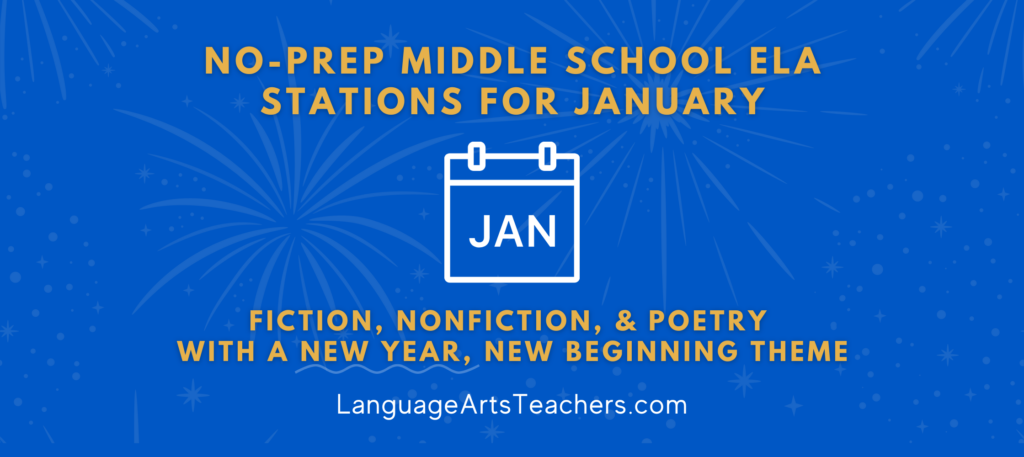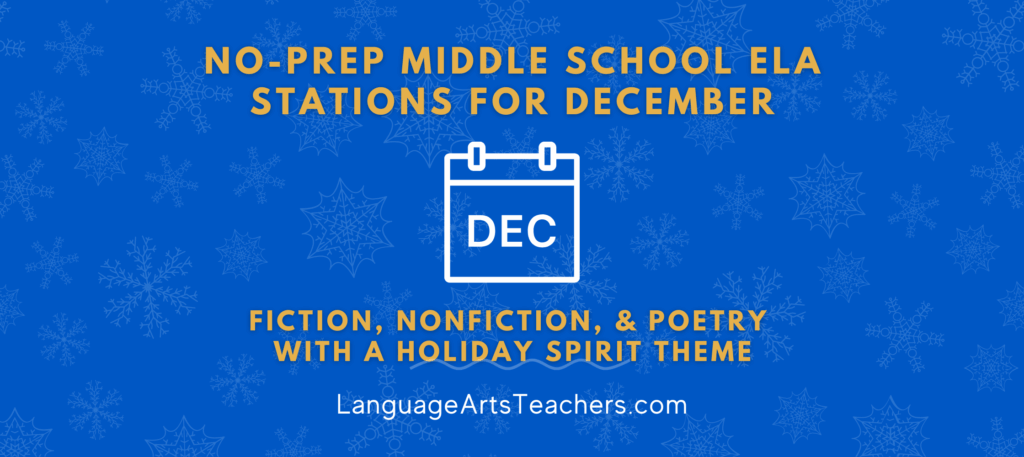The most common questions I get when it comes to test prep in the Middle School ELA Classroom are these >>
When do you start reviewing?
→ Pretty much from Day 1 of the school year, because the way I do it, students aren’t even aware at all that we’re “reviewing for the test.”
→ How? One example is by simply being very intentional and strategic with what words, phrases, and questions I’m asking students. I begin using academic, domain-specific vocabulary right away so that genre, author’s purpose, internal conflict, point of view, stanza, etc. become the normal language that we all use in the classroom all the time.
*** I’ll share specifics in a sec about academic, domain-specific vocabulary
How many weeks (or months) before the BIG test do you start?
→ When we’re always using sentence stems, academic vocabulary, close-reading strategies, etc. anyway, then we’re always practicing and reviewing and working towards mastery of the same skills students will need to get the best results they can get (based on where they are when they enter my classroom for the first time).
*** Don’t worry. ^That’s just a quick overview response and I’ll go into more detail in a bit on what those strategies look like in my class.
How do you keep your students engaged so they don’t burn out?
→ I switch up WHAT students are doing with all the sentence stems, vocabulary, inference, and everything else that we’re working on all throughout the year. I’m talking about hands-on experiences, small group and independent work, speaking and listening components that all go outside of and beyond a standard practice test worksheet situation.
*** There’s always a time and a place for the typical practice test worksheet stuff, but what I’m sharing with you in a moment is different from that since the goal here is to NOT burn out on test prep early on.
{And also so that YOU don’t burn out, either}

Here’s what I’m sharing with you right here, right now, about test prep:
- No-prep academic vocabulary strategies for retention
- How to help students make logical inferences across genres
- Ways to use question & sentence stems so students understand the lingo
- Interactive Games & Engaging Hands-On Ideas → I wrote up a quick-reference list of resources a while back that covers this, so I won’t repeat myself here 🙂
Let’s take ^each ^of ^those ^topics one at a time, with some quick-action tips that you can implement immediately into your classroom, like tomorrow, if you wanted to.
Academic vocabulary strategies for retention
In isolation, students may be able to tell you what the word “infer” or “inference” means. They’ll also probably be able to explain what “text evidence” is.
But when we embed those terms into actual “test-style” questions like:
- How is the reader able to infer that _______ is happening in the selection?
- Which of the following statements represents the best text evidence to support the speaker’s claim that ________ ?
- The author conveys a feeling of __________ in lines 6 – 9 of the excerpt. . .
There’s a lot going in those types of typical test questions! It’s not just what is “infer” or what is “text evidence” anymore. We’ve got “selection” and “support the speaker’s claim” and “conveys” and “excerpt” to contend with.
This is where students typically say, “I don’t get what this is asking.”
And they’re right!
So my strategy for academic vocabulary retention is that we spend a great deal of time working through what questions are really asking.
I don’t ever want my students to miss a question simply because they didn’t understand what it was asking.
Therefore, it’s a norm in my class (or small group, or intervention, or whatever I’m teaching) that we spend time looking at the questions.
- We paraphrase them in our own words.
- We ask them in different ways while also making sure we don’t inadvertently change the meaning of the question.
- We also come up with our own answer to the question BEFORE really looking at the answer choices because we also don’t want to feel “tricked” or confused by similar answer choices.
In fact, we sometimes look at questions like this without reading the passage, and without answering them at all. Sometimes the full lesson in and of itself is simply understanding what we are being asked to do.
The same strategy works with the writing prompts that some grade levels are tested on. In my early years of teaching, when I taught AP English at the high school level, we spent a LOT of time simply breaking down, unpacking, and ensuring full understanding of the complex AP test writing prompts as a lesson. That means. . . Looking at half a dozen prompts without ever officially writing to the prompts.
And we can do the same thing with our middle school students when it comes to questions and the way those questions or prompts are written.
All ^that is to say this: For the most natural, no-prep, consistent way to ensure retention of academic, domain-specific vocabulary, spend time all throughout the year literally working with the style of questioning: talking about it, paraphrasing it, grabbing any teachable moment you can. Make it the norm in your classroom that you just always spend time on what questions are asking, the way they’re asking, and what we’re supposed to do with the questions.
Grab a spot at my FREE “Test Prep Strategies” online training because I’ll be providing several unique freebies and resources that you can use right now in your classroom to engage your students and help them review . . . without the feel of a traditional (yawn) review experience. I know you’ll find it wildly valuable. Game changer, for sure!
How to help motivate students make logical inferences across genres
The key to engaging students in the process of making not just inferences, but logical inferences based on text evidence is to involve them in different ways.
Here’s my ALL TIME FAVORITE way to do this (I can get away with this one about once a quarter, maybe twice, but not more than that):
I love to give my students part of a practice test or even just a passage with that lovely “these looks like test questions” vibe BUT those multiple choice questions?
I already answered them!
Yup! I give them the passage, the multiple choice questions, and my own circles around the answers.
And how did I get the answers? I just randomly circled them ahead of time. Some may be right, and most will probably be wrong.
The assignment? Y’all have to grade me! See how I did! What did I make?
And the real kicker? Each group gets the same passage with the same multiple choice questions BUT I really DID go through and just randomly circle whatever I wanted for each group so . . . There are all kinds of fun ways you can mix it up!
The point is that now students have to read, re-read, figure out if my answer for each question is correct, or if I chose “the next best answer” instead (because you know how those multiple choice tests always seem to have two “good” answers but really we’re looking for the BEST answer?
And to do ^that, students absolutely HAVE to HAVE to HAVE to be able to logically and accurately justify their reasons for why I got an answer right or wrong—
> > Which means they’re double- and triple-checking their inferences, using text evidence, going back to see what each question was really asking, etc.
^^^All the test-taking skills we want them to practice and engage with, right?
That’s my favorite strategy for drumming up excitement around helping my students to make logical inferences using text evidence. . . But I’ve actually got several more to share with you like that with images and examples, too. I’ll pass them on to you during my next FREE online training, and you’re invited!
⭐️If you are currently looking for an online English teacher position, give Jooble a try!⭐️




